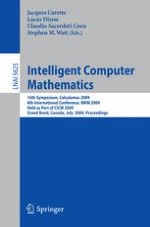As computers and communications technology advance, greater opportunities arise for intelligent mathematical computation. While computer algebra, au- mated deduction and mathematical publishing each have long and successful histories, we are now seeing increasing opportunities for synergy among them. The Conferences on Intelligent Computer Mathematics (cicm 2009) is a c- lection of co-located meetings, allowing researchers and practitioners active in these related areas to share recent results and identify the next challenges. The speci?c areas of the cicm conferences and workshops are described below, but the unifying theme is the computerized handling of mathematical knowledge. The successful formalization of much of mathematics, as well as a better - derstanding of its internal structure, makes mathematical knowledge in many waysmore tractable than generalknowledge,as traditionally treatedin arti?cial intelligence. Similarly, we can also expect the problem of e?ectively using ma- ematical knowledge in automated ways to be much more tractable. This is the goal of the work in the cicm conferences and workshops. In the long view, so- ing the problems addressed by cicm is an important milestone in formulating the next generation of mathematical software.
